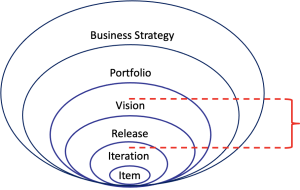
If a project or product starts poorly; it’s unlikely to end up in a better spot.
To systematically improve the chances of success of any delivery initiative (product, project or even organizational change), running an Inception Workshop at the beginning of an initiative will go a long way to creating better outcomes by reducing risks, building trust and aligning around value.
While every Inception workshop varies with context, key outcomes will typically include:
- Establishing a product vision and measurable outcomes
- Elucidation of key customers and users
- Prioritization of high level feature backlog towards a Minimum Viable Product
- Definition of initial user experience design and technical architecture
- Identification of impediments, dependencies and risks
- Clarification of team roles, stakeholders, Agile processes and tools
Looking at the planning layers within an Agile context, the Inception Workshop starts with a known vision for a product and extends into the start of the Iterative Delivery process — without getting into the elaboration of a Product Backlog.

Lead by an experienced facilitator, there are both preparatory and post-workshop components to maximize the investment in Inception Workshops. These workshops, ranging from 1 to 5 days (typically 1 or 2 days) can then be run on an ongoing basis, often every 3 to 4 months, as part of ongoing alignment and release planning cadence.
Of course, it’s not just about what happens in those two days of intense collaboration, but also how things are orchestrated leading up to the Inception Workshop and what happens afterwards:
- Preparation: Two to four weeks prior to an Inception Workshop a kick-off meeting needs to occur with key roles to align on the agenda, participants and necessary inputs, such as user research, prototypes, technical spikes and related Discovery efforts.
- Participants: The size of workshop varies from a dozen to close to 100, depending on the size of the product program or portfolio. Anyone involved in actual product development needs to be present for the full session, along with decision makers and customers (or their proxies).
- Post-Workshop: A lot of new information, ideas and insights are generated in an Inception Workshop, and some time needs to be allocated to harvest everything and provide the team to get organized for their next sprint.
Additionally, a high-level sample agenda for a typical 2-day Inception Workshop could look like this:

Inception High Level Agenda
Getting an Inception Workshop design and delivered for a team can be a very rewarding experience for everyone involved. Not only will it directly impact the future success of a project/product, but will also help create a sense of team and solid momentum that can be carried forward.
Further Resources:
- Lean Inception, Paulo Caroli
- The Agile Samurai, Jonathan Rasmusson
- Liftoff: Launching Agile Teams and Projects, Diana Larsen
